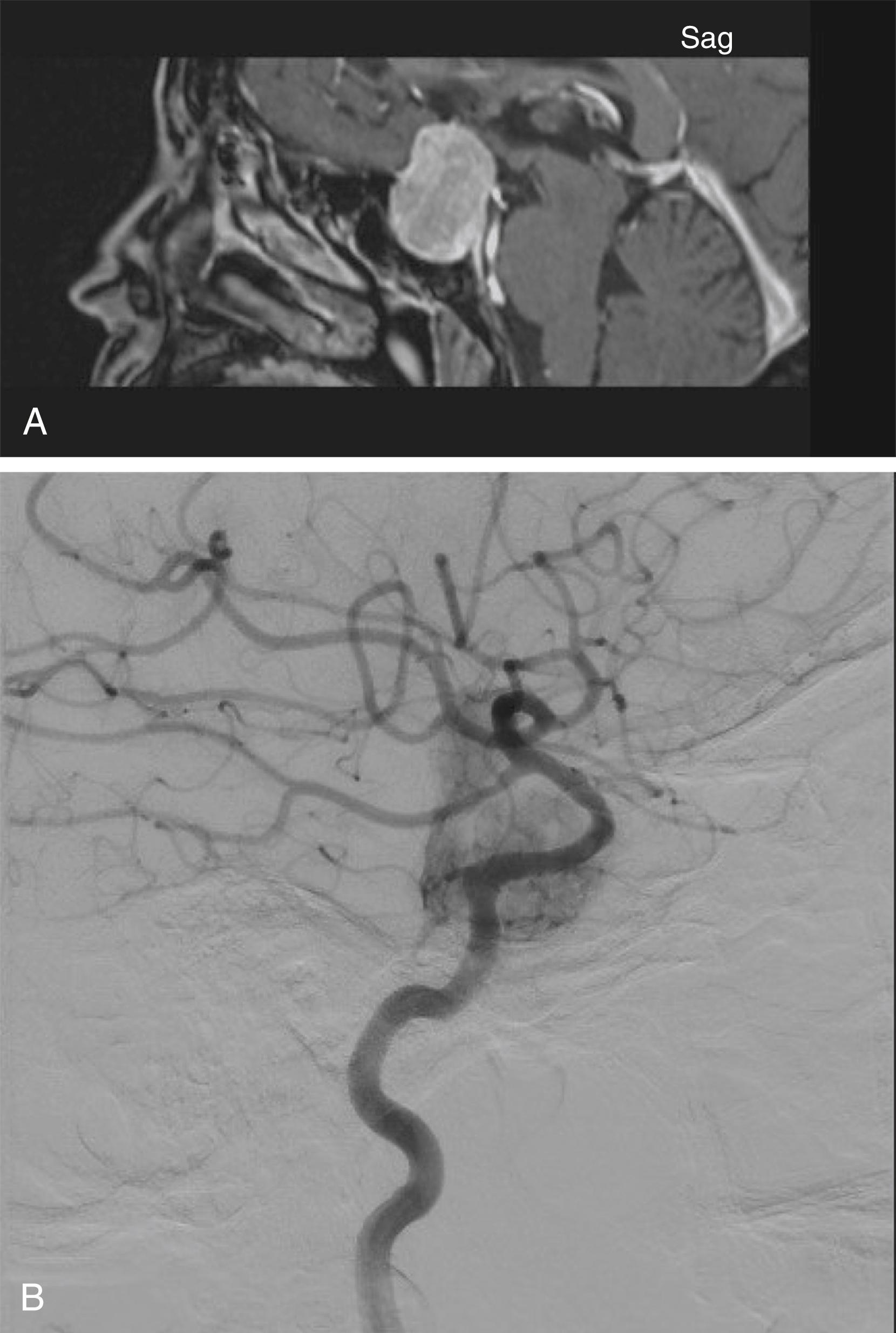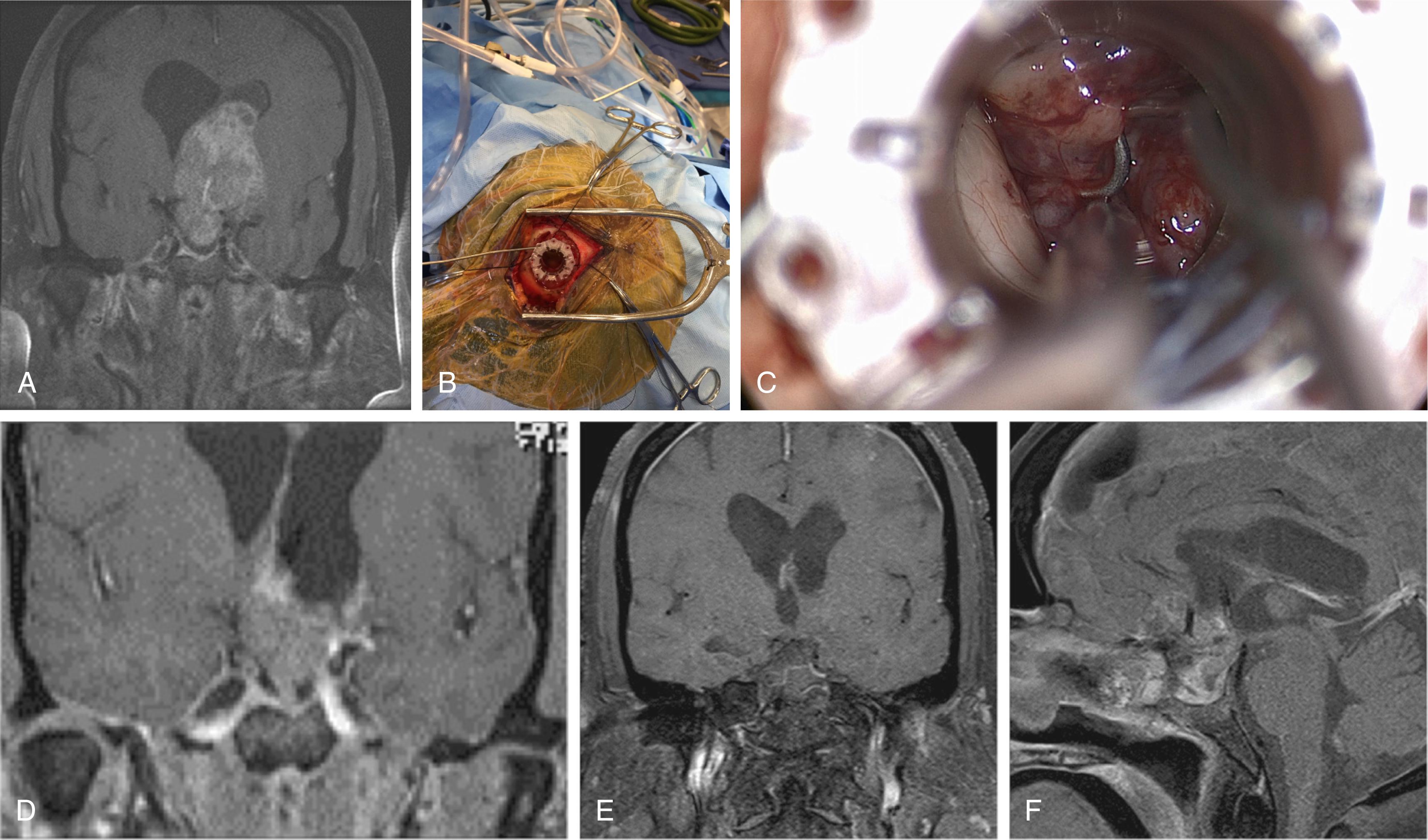Physical Address
304 North Cardinal St.
Dorchester Center, MA 02124
The most common tumors affecting the sellar, suprasellar, and parasellar regions include pituitary adenomas, Rathke cleft cysts, craniopharyngiomas, meningiomas, germ cell tumors, and gliomas involving the hypothalamus or optic chiasm. Management is dictated according to each specific diagnosis. Although medical therapies can be utilized in a subset of patients, many lesions require surgical management, which is most commonly carried out using a transsphenoidal approach. Sellar and suprasellar tumors are typically treated via a transsphenoidal approach because these operations provide direct access to the tumor with preservation of normal pituitary tissue, are less invasive, and have a quicker recovery of visual defects due to minimal manipulation of the optic nerves and chiasm. Despite the advantages of the transsphenoidal approach, a minority of pituitary tumors cannot be completely resected via a transsphenoidal approach and require transcranial surgery.
The most common indications for transcranial surgery for pituitary tumors are: (1) failed transsphenoidal surgery; (2) extension of the tumor lateral to critical neurovascular structures; (3) other indications including kissing carotids, lack of sphenoid sinus pneumatization (i.e., conchal), sinus infection in the setting of acute apoplexy, severe sleep apnea with associated inability to tolerate being off continuous positive airway pressure (CPAP) therapy, and association of the adenoma with an aneurysm. Although tumor size (e.g., giant adenoma >4 cm) used to be considered an indication, in the current era of endoscopic approaches, size in and of itself is no longer considered a specific indication for transcranial surgery. The advantages and disadvantages of each approach must be weighed against the potential risks and benefits in deciding the most appropriate approach.
Improvement of reconstruction techniques in endonasal surgery has diminished the role of transcranial surgery for pituitary adenoma. Although expanded endoscopic approaches have developed significantly, it was the description and use of the pedicled nasoseptal flap in 2006 that introduced a reliable technique to repair larger endonasal skull base defects with vascularized tissue. The use of the vascularized nasoseptal flap enabled the development of expanded approaches and therefore limited the indications for transcranial surgery for pituitary macroadenoma.
While the transsphenoidal approach is now standard for resection of sellar/suprasellar region tumors, there are specific limited indications for transcranial approaches. Familiarity with specific indications is important to appropriately understand how to balance selection between endonasal and transcranial approaches for pituitary adenomas.
These indications are as follows:
A major indication for a transcranial procedure is a failed transsphenoidal surgery. Failure can occur for multiple different reasons.
Any characteristic intrinsic to the tumor itself that does not allow the tumor to fall into the sella compromises the efficacy of transsphenoidal surgery. Infrequently, pituitary macroadenomas may be extremely fibrous, and resection of these tumors can be considerably more dangerous because of the need for sharp debulking, placing the carotid arteries and optic apparatus at increased risk for injury. In these cases, ultrasonic aspirators and side-cutting rotatable microdebriders can be helpful in performing tumor debulking, with location of the carotid arteries repetitively confirmed with neuronavigation and the micro-Doppler. In rare cases where adequate decompression cannot be safely performed through a standard transsphenoidal transsellar opening, the open craniotomy has an indication.
If the tumor extends lateral or superior to the mid-optic line, this extension frequently prevents total resection through a transsphenoidal approach. In such cases, if there is significant tumor bulk remaining, if the tumor is functional, or if there is progression of residual tumor, a transcranial approach can be considered. The failure can occur also when there is major vascularity of the tumor, which significantly hampers the ability to safely remove the tumor. In this condition, only partial debulking is possible and abortion of further resection may be necessary due to significant blood loss ( Fig. 16.1 , Case 1).

Recurrent pituitary adenomas are no longer a specific indication for a transcranial approach. Yoshua Esquenazi et al. showed in the meta-analysis that the use of the endoscopic endonasal approach is currently a widespread technique for approaching residual and recurrent pituitary adenomas. In addition, endoscopic approaches have been shown to be more effective at achieving gross total resection of recurrent pituitary macroadenomas, particularly when they were initially treated through traditional microscopic approaches.
Pituitary adenomas can invade one or both cavernous sinuses. While the transsphenoidal approach is generally limited to the compartment of the cavernous sinus medial to the cavernous and clinoid segments of the internal carotid artery, this approach can be used in patients with nonsecreting adenomas in which tumor debulking and neurovascular decompression is sufficient. If the adenoma is secretory (functional) or if the parasellar extension ventures beyond the cavernous sinus into the middle fossa, transcranial approaches can be considered.
It was once thought that the degree of suprasellar extension would determine transsphenoidal versus open craniotomy but this is no longer the case. We believe suprasellar extension itself is no longer a limitation of transsphenoidal approaches although massive tumors extending past the foramen of Monro into the lateral ventricles may be an indication for combined transsphenoidal and transcranial approaches ( Fig. 16.2 , Case 2).

Tumors with significant suprasellar extension may not descend and thus the superior most aspect of the tumor may not be reachable with standard microscopic transsphenoidal approaches. However, suprasellar tumor extension in the midline/sagittal plane can be safely resectable with endoscopic approaches (e.g., trans-tubercular, transplanar) and with usage of contemporary instrumentation (e.g., angled endoscopes, malleable suctions/curettes) (see Fig. 16.2 , Case 2).
Pituitary adenomas are associated with aneurysms at double their expected frequency. , If an aneurysm adjacent to a pituitary adenoma (i.e., an aneurysm of the anterior cerebral artery) is detected preoperatively, both lesions can be potentially treated in the same operation. Co-treatment of these lesions is more applicable when an aneurysm will be affected by manipulation of the regional anatomy. Alternative treatment strategies include a staged-procedure, surveillance of either lesion or nonsurgical treatments such as endovascular coiling for the aneurysm and radiotherapy for the pituitary adenoma. Another option would be endovascular coiling for the aneurysm and transsphenoidal resection of the adenoma.
Ectatic vessels (e.g., kissing carotids) can also pose a problem for transsphenoidal approaches. The intercarotid distance of the clinoidal and cavernous segments of the internal carotid arteries and its relationship of the tumor should be taken into account when deciding on an appropriate approach. There is commonly a 1 to 3 mm separation between the medial margin of the internal cerebral arteries and the lateral surface of the pituitary gland. Ectatic carotid arteries can veer into the midline trajectory making a transsphenoidal approach unsafe in less experienced hands. ,
In the setting of active sinus infection, pituitary surgery is typically delayed in order to first treat the sinus infection prior to proceeding with a transsphenoidal approach. However, in the setting of acute neurological deterioration, such as that seen in apoplexy, a delay to treat a sinus infection is not appropriate and a transcranial approach is warranted.
Patients with sleep apnea typically can tolerate being off of CPAP therapy on a temporary basis without significant morbidity. Thus, stopping CPAP is appropriate in most patients undergoing pituitary via a transsphenoidal approach. However, certain patients experience cardiac complications while off CPAP therapy and withholding CPAP, even temporarily, can be associated with significant morbidity. In such cases, a transcranial approach should be selected to avoid the potential morbidity associated with suspending CPAP therapy.
The preoperative work-up for patients with signs or symptoms of a sellar neoplasm should include formal visual field testing and complete pituitary endocrine evaluation. A T1-weighted magnetic resonance imaging (MRI) scan with and without gadolinium in the sagittal and coronal planes also should be performed to allow proper visualization of the optic nerves, optic chiasm, carotid arteries, cavernous sinuses, and surrounding soft tissue. A T2-weighted scan may be useful in determining the fibrotic nature of a tumor in this region to aid in surgical planning. Although no reliable predictor exists, evidence suggests that pituitary adenomas with a homogeneously isointense, as opposed to hypertense, signal on T2-weighted MRI are predicted to be firm and fibrotic, although this is not routinely used radiologic criteria. With advancements in MRI technology, there are now imaging sequences that provide better visualization of the pituitary and sellar anatomy. One such sequence is constructive interference in steady state (CISS), which is a T2-weighted gradient echo MRI sequence. The CISS sequence provides better visualization of the cranial nerves and cisternal spaces as well as sellar pathologies due to its ability to accentuate T2-weighted values between cerebrospinal fluid (CSF) and surrounding structures. Moreover, the CISS sequence has been demonstrated to be superior to standard T1- and T2-weighted sequences for delineating key structures around the sellar region, including the optic nerve, optic chiasms, oculomotor nerve, pituitary stalk, and small vessels, thus making it useful for preoperative planning. The CISS sequence is also valuable for the preoperative evaluation of cavernous sinus invasion.
Craniotomy for tumors in this region carry the same general risks as any operation (i.e., deep vein thrombosis, bleeding, infection, anesthetic risks); however, there are specific risks associated, such as damage to the optic nerves (resulting in impaired vision or visual fields), damage to the internal carotid artery or anterior cerebral artery, and damage to the pituitary stalk (resulting in hypopituitarism and diabetes insipidus [DI]). The potential for harm of vascular structures in this area necessitates accurate preoperative evaluation of the vessels using computed tomography (CT) angiogram. The use of CT angiogram images in intraoperative navigation and intraoperative Doppler ultrasonography are useful tools to avoid vascular injury during surgery.
Anticonvulsants should be started preoperatively because seizures are possible after transcranial surgery. CSF rhinorrhea or anosmia can occasionally occur; however, retractorless operations have decreased the occurrence of these complications.
When the tumor is hormone secreting (i.e., functional adenoma), complete safe resection is necessary to achieve a biologic cure. A nonfunctional tumor does not necessarily require complete resection, especially if the risks of such an attempt are significant. In these circumstances, the aims should be an adequate debulking of the tumor to achieve satisfactory optic decompression.
The front osphenotemporal or pterional craniotomy is the most commonly used transcranial approach to pituitary tumors. It was popularized by Yaşargil as an approach to intracranial aneurysms and is now the most widely used transcranial approach in neurosurgery.
It provides the direct path to the sella turcica and allows removal of large pituitary tumors with minimal brain retraction. It should also be the transcranial approach of choice for tumors when a prefixed chiasm is present as the tumor can be resected safely underneath the optic chiasm.
Become a Clinical Tree membership for Full access and enjoy Unlimited articles
If you are a member. Log in here